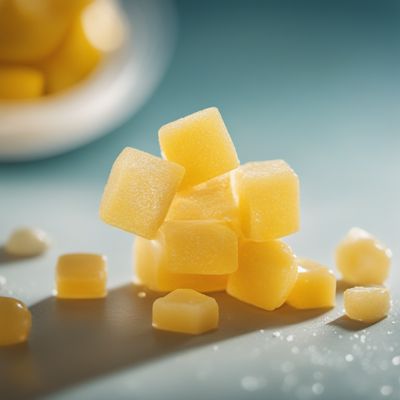
Ingredient
Jelly candies
"Gooey Delights: Exploring the World of Jelly Candies"
Jelly candies are bite-sized confections made from a mixture of sugar, gelatin, and fruit juice or flavorings. They come in a variety of shapes, sizes, and flavors, ranging from fruity to sour to sweet. With their soft and chewy texture, jelly candies provide a delightful mouthfeel that is both satisfying and fun to eat. Their vibrant colors and playful shapes make them visually appealing, adding to their overall appeal as a popular treat.
Origins and history
The origins of jelly candies can be traced back to ancient times, with evidence of similar confections being enjoyed by the Egyptians and the Romans. However, it was not until the 19th century that jelly candies as we know them today started to gain popularity. In 1845, the first commercially produced jelly candy, known as Turkish Delight, was introduced in the United Kingdom. From there, jelly candies spread across Europe and eventually made their way to the United States, where they became a staple in the candy industry.
Nutritional information
Jelly candies are typically high in sugar and calories, providing a quick source of energy. They are low in fat and protein, but do not offer significant nutritional value beyond their caloric content.
Allergens
Jelly candies may contain gelatin, which is derived from animal sources, making them unsuitable for vegetarians and vegans. Additionally, some jelly candies may contain allergens such as gluten, soy, or dairy, depending on the specific ingredients used.
How to select
When selecting jelly candies, look for brands that use natural fruit juices or flavorings for a more authentic taste. Avoid candies that have a sticky or melted appearance, as this may indicate poor quality or improper storage. Opt for candies that have a firm yet chewy texture, as this indicates freshness.
Storage recommendations
To maintain the freshness and quality of jelly candies, store them in a cool, dry place away from direct sunlight. It is best to keep them in an airtight container to prevent them from becoming sticky or absorbing moisture from the environment.
How to produce
Producing jelly candies at home requires specialized equipment and knowledge of candy-making techniques. It is recommended to leave the production of jelly candies to professional confectioners.
Preparation tips
Jelly candies are ready to eat straight out of the package. They can be enjoyed on their own as a sweet treat or used as a topping for desserts such as ice cream or cakes. For a fun twist, try incorporating jelly candies into homemade trail mixes or using them as a decorative element in baked goods.
Culinary uses
Jelly candies are primarily enjoyed as a standalone treat or used as decorative elements in desserts. They can be added to cakes, cupcakes, or cookies to add a burst of color and flavor. Some creative chefs even use jelly candies as a filling for chocolates or as a garnish for cocktails.
Availability
Jelly candies are widely available in supermarkets, candy stores, and online retailers. They can be found in various brands and flavors, making them accessible to consumers worldwide.
More ingredients from this category
Recipes using Jelly candies

Shwe Yin Aye - Burmese Coconut Milk Dessert
Golden Delight: A Sweet Journey through Burmese Coconut Milk Dessert

Kagemand - Danish Celebration Cake
Whimsical Danish Celebration Cake: Kagemand Delight

Refreshing Tropical Delight Limber
Tropical Paradise on a Stick

Nasi Goreng with a Molecular Twist
Molecular Gastronomy Nasi Goreng: A Fusion of Flavors

Papparoti Buns with a Twist
Caramel-Filled Korean Papparoti Buns: A Sweet Delight

Chinese Imperial Halo-Halo
Imperial Delights: A Fusion of Chinese Elegance and Filipino Sweetness

Bavarian Pavlova
Bavarian Dream Delight

New Zealand Chocolate Fish Delight
Decadent Kiwi Chocolate Fish Delight

Jellied Eels with a Twist
Savory Delight: Modern Jellied Eels



